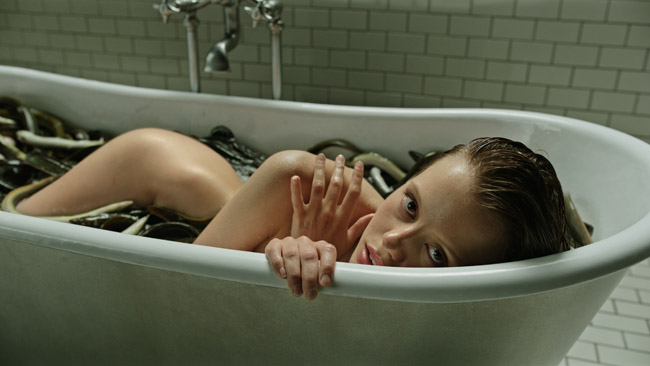Writhing eels, flotation tanks and something iffy in the water. But is A Cure For Wellness a tonic or just another placebo?
That blue bottle on the poster for Gore Verbinski’s A Cure For Wellness has a message. And, with no apologies whatsoever to the legendary Monty Python sketch, that message is “beware”.
The film starts off promisingly enough, with financial whizz-kid Lockhart (Dane DeHaan despatched to a health retreat in the Swiss mountains to bring back his company’s CEO. The boss needs to sign on the dotted line to make a merger happen, but the truth is that Lockhart is doing it to save his own skin and cover up some dodgy dealings. A car crash means that he ends up stuck at the retreat, where he becomes fascinated by Hannah (Mia Goth), the only other young person there. Then he becomes suspicious of the water that everybody guzzles by the gallon. And why does nobody ever leave the place?
The premise isn’t anything new, although there’s nothing wrong with that per se. Setting a horror/fantasy inside the confines of a remote medical establishment is familiar enough – Shutter Island, for one – although they’re usually mental hospitals and not health spas. But that’s really the only difference because it’s obvious even before Lockhart gets there that something very strange is going on. Well, there would be ……
To give the film its due, it really does look gorgeous and there are some ravishing visual set pieces. The journey on the train through the Swiss mountains makes stunning use of light and reflection and the sanatorium is superbly re-created, an Edwardian creation with wooden sweat boxes and huge flotation tanks like massive siloes. The contrast with the outside world, all sleek skyscrapers and lives conducted via mobile phone, is sharply defined and the car crash that prevents DeHaan leaving is dramatic and immediate. Cinematographer Bojan Bazelli, a Verbinski regular (The Lone Ranger, The Ring) has done a fabulous job.
If only the film as a whole was as good. While we should be asking ourselves how much of what Lockhart is seeing is in his head and how much is for real, the question never even arises because it’s so obvious from the very start. And, although Verbinski has set out to unsettle, shock and frighten us, he never manages that either. Perhaps the only exception is one scene involving some Edwardian-style dentistry. Put it this way, if you’re going to the dentist soon, make sure your appointment is before you go to see the film – assuming you decide to. It might make you wince, but it’s certainly not frightening. And, as for the writhing eels that keep popping up, once you’ve seen one, you’ve seen ‘em all.
It would be comforting to think that Verbinski was aiming to make us think about our working lives and how they affect our health. If that was the idea, his choice of DeHaan with his permanently tired look is spot on. But the storyline just doesn’t deliver on that front. It’s old fashioned, convoluted and stretched to just a smidge under two and a half hours: there’s at least three times when it looks like it’s going to end and then, no, off it goes again! He’s tried to disguise its shortcomings with the cinematography and, gorgeous though it may be, we can see through them. The end result falls down on just about every front – overlong, shallow and not in the least bit disturbing.
A Cure For Wellness is in cinemas from Friday, 24 February.













